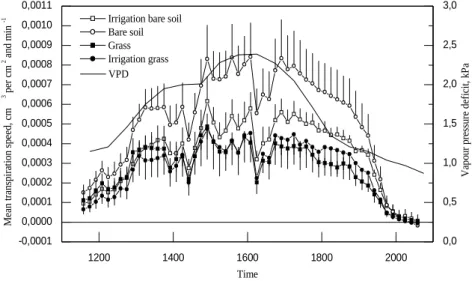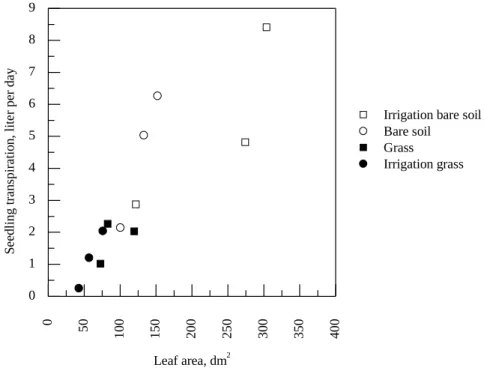HAL Id: hal-00964248
https://hal.archives-ouvertes.fr/hal-00964248
Submitted on 7 Jun 2020HAL is a multi-disciplinary open access archive for the deposit and dissemination of sci-entific research documents, whether they are pub-lished or not. The documents may come from teaching and research institutions in France or abroad, or from public or private research centers.
L’archive ouverte pluridisciplinaire HAL, est destinée au dépôt et à la diffusion de documents scientifiques de niveau recherche, publiés ou non, émanant des établissements d’enseignement et de recherche français ou étrangers, des laboratoires publics ou privés.
Effect of field vegetation control on water flux in oak
seedlings evaluated by the heat balance method
Magnus Löf, Thierry Ameglio, André Granier, Catherine Collet
To cite this version:
Magnus Löf, Thierry Ameglio, André Granier, Catherine Collet. Effect of field vegetation control on water flux in oak seedlings evaluated by the heat balance method. 4. International Conference on Forest Vegetation Management, Jun 2002, Nancy, France. 3 p. �hal-00964248�
EFFECT OF FIELD VEGETATION CONTROL ON WATER FLUX IN
OAK SEEDLINGS EVALUATED BY THE HEAT BALANCE METHOD
Magnus Löf*1, Thierry Améglio2, André Granier3, Catherine Collet3
1Swedish University of Agricultural Sciences, Southern Swedish Forest Research Centre,
Box 49, S-230 53 Alnarp, Sweden. Tel: +46 40 41 51 19. Fax: +46 40 46 23 25. E-mail: magnus.lof@ess.slu.se
2UMR PIAF, centre INRA de Clermont-Ferrand, France 3Centre INRA de Nancy, Champenoux, France
Introduction
In Europe, oak species are among the preferred species in terms of sustainable land use. Oaks are grown at fertile sites, where the development of natural vegetation is abundant. One of the major problems in the regeneration of oak stands is the competition with natural vegetation (Collet et al. 1996, Davis 1985). When explaining growth in seedlings during competition between herbaceous vegetation and seedlings, soil water content is often used to define the availability of water (Löf 2000). The rate of photosynthesis is correlated to transpiration rate and studies shows a strong relationship between growth of plants and the amount of water consumed (Hanks and Rasmussen 1982). However, seedling transpiration does not necessary follows the availability of soil water content (Améglio et al. 1999, Löf and Welander 2000) and it is important to measure seedling transpiration in order to evaluate the importance of water competition in the seedling-grass interaction.
The constant stem heat balance method that was first implemented on small plants by Sakuratani (1981, 1984). It was later developed and commercialized (Baker and Van Bavel 1987, Steinberg et al. 1990). However, one disadvantage with this commercially available technique is that heat storage of the stem is not taken into account, something that may lead to incorrect results. This has been taken into consideration when the method has been improved by measuring heat storage (Valancogne and Nasr 1993).
In this study we used the latter method for measuring the response in seedling transpiration to four different treatments of vegetation control. The specific objectives of the study were: 1) to examine whether grass limit water uptake in seedlings; 2) to figure out if it is possible to use the technique for measuring transpiration in small seedlings over long periods.
Materials and Methods
The experiment was set up at a field near Nancy, eastern France. In May 1998 one-year-old bare root oak seedlings (Quercus petraea) and grass (Deschampsia cespitosa) were planted in clay soil. Two treatments (bare soil and grass) were applied from spring 1998 until autumn 2000. Both treatments were regularly irrigated during summer to avoid soil water deficit. In spring 2001, only half the plots were irrigated for obtaining dry conditions in half of the experiment. Thus, in 2001 the treatments were: 1) Irrigated bare soil; 2) Bare soil; 3) Irrigated grass and 4) grass.
In the summer of 2001, seedling transpiration was measured with the heat balance method according to Valancogne and Nasr (1993). In each of the treatments, three seedlings, with a basal diameter ranging from 1 to 2 cm were selected. The sap-flow sensors were installed at the end of June 2001 and measurements were taken from the middle of August to the middle
of September. Only one level of heating power was used during day and night. The
measurement system consisted of a series of thermocouples and a heating system installed at seedling base, and connected to a datalogger and a multiplexor (Campbell, Scientific Inc., UK). Measurements were made every minute and 10-minute-average values were collected.
A high number of seedlings presented a multiple-stemmed morphology. On these seedlings, sap flow was measured on one stem, and whole seedling transpiration was calculated by multiplying the values obtained on the selected stem by the ratio of total seedling leaf area to the leaf area on the selected stem. The leaf area on the selected stem and of the whole seedling were calculated using dry mass of leaves and the leaf area ratio of sub-samples.
Results and Discussion
An example of sap flow (≈ transpiration) is given in Figure 1. Mean sap flow followed
vapour pressure deficit during day time with a large variability among seedlings. The bare soil treatments resulted in higher sap flow in seedlings than in the grass treatments, irrespectively if combined with irrigation or not (Figure 1). However, during other days these differences were equalized (data not shown). The amount of water consumed per seedling was correlated to total leaf area without distinct differences between treatments (Figure 2). Total leaf area was reduced in treatments with grass.
In the end of August, soil samples were taken in the two grass treatments. Drought was
recorded in one layer at about 20 cm soil depth in the part that was not irrigated. However, the growing season of 2001 was wet and cold and probably no large differences in soil moisture occurred between the four treatments.
1200 1400 1600 1800 2000 -0,0001 0,0000 0,0001 0,0002 0,0003 0,0004 0,0005 0,0006 0,0007 0,0008 0,0009 0,0010 0,0011 M ea n tra ns pi ra tio n sp ee d, c m 3 p er c m 2 a nd m in
-1 Irrigation bare soil
Bare soil Grass Irrigation grass Time 0,0 0,5 1,0 1,5 2,0 2,5 3,0 V ap ou r p re ss ur e de fi ci t, kP a VPD
Figure 1. Mean (n=3, in each treatment) sap flow in four treatments during a sunny day in August 2001. Sap flow=cm3 (water) per cm2 (leaf area) per minute.
We conclude that the heat balance method is a valuable tool in studies of competition between herbaceous vegetation and seedlings. Principally, since it give very detailed information on transpiration. However, problems occur when information on transpiration is needed over long time periods. First, several tree species have a periodic shoot elongation with several flushes. Thus, total leaf area of seedlings has to be measured continuously over the
measurement period. Secondly, in treatments with rapid growth the stem diameter change. Stem diameter is one of the base-variables for calculating the heat fluxes in the heat-balance method. This means that a variable stem diameter has to be used for the calculations or even that the sensor may need to be changed to adjust a larger diameter. Finally, we observed secondary root growth and fungus on the stem when the sensors were taken away after the experiment, but we do not know if that can modify the calculation of the transpiration.
0 50 10 0 15 0 20 0 25 0 30 0 35 0 40 0 0 1 2 3 4 5 6 7 8 9
Irrigation bare soil Bare soil Grass Irrigation grass Se ed lin g tr an sp ir at io n, li te r pe r da y Leaf area, dm2
Figure 2. Mean daily transpiration in relationship to seedling leaf area in four treatments during a sunny day in August 2001. Each point represent one seedling.
References
Améglio, T. et al. 1999. Plant and Soil. 207: 155-167.
Baker, J.M., Van Bavel, C.H.M. 1987. Plant. Cell and Environment. 10: 777-782. Collet, C. et al. 1996. Can. J. Bot. 74: 1555-1561.
Davis, R.J. 1985. Forestry. 58: 167-180.
Hanks, R.J., Rasmussen, V.P. 1982. Adv. Agron. 35: 193-215. Löf, M. 2000. Can. J. For. Res. 30: 855-864.
Löf, M. and Welander, N.T. 2000. Can. J. For. Res.30: 465-475. Sakuratani, T. 1981. Journal of Agricultural Meteorology. 37: 9-17. Sakuratani, T. 1984. Journal of Agricultural Meteorology. 40: 273-277. Steinberg, S.L. et al. 1990. J. Exp. Bot. 41: 653-659.

